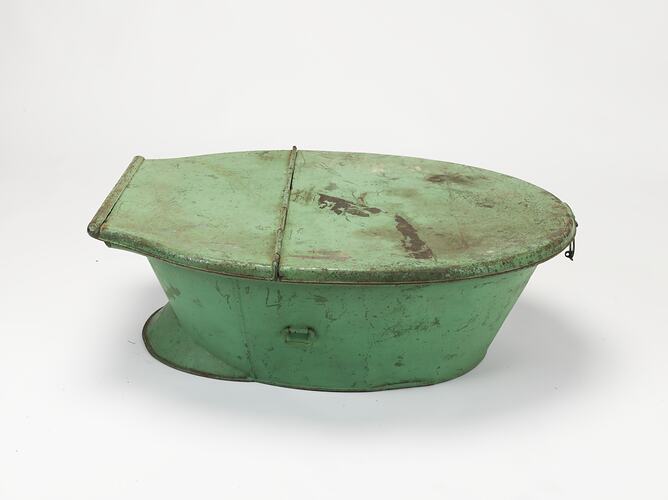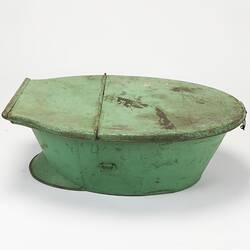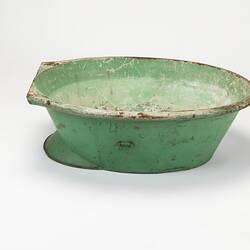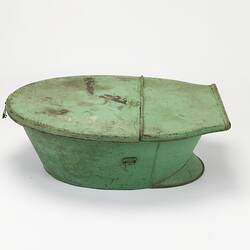Summary
Alternative Name(s): Travelling Bath
Green, painted metal travel bath with lid brought to Australia by the Davies family, who migrated during the mid-nineteenth century. On 15 December 1852, John Francis Davies, accompanied by his wife Maria Bele and their three daughters, Martha Jane, Emily Eleanor and Maria, plus Martha's husband William Piper Brown, emigrated from England and arrived in Melbourne in April 1853. In England, John had owned a factory manufacturing shoes and thus his journey encompassed the transportation of his personal belongings, including family artefacts, silk paintings and household furniture.
Family lore recalls the bath travelling with the family from England and it being used en-route as both bath and trunk. This object has passed down several generations, and the donor's family recalls the bath from around the1920s as being a functional everyday object for family bathing.
Physical Description
Sheet iron container with sealable lid. Primarily oval in shape which at the rear widens to a horizontal edged finish (toilet seat shape). Lid is constructed of two sections joined at 305mm from rear edge by a three hinged system. The bath's body tapers to a circumferential base of 1675mm with an additional foot section of approximately 60mm. The lid is secured via a key lock fastening device centrally positioned at the bath's front edge. Furthermore, on the bath's sides are two corresponding handles measuring 50 x 25mm that would have accommodated an additional strap to secure lid when object was in transit. Object is painted green, and exhibits various scratches and rust pockets. Additionally, centrally located on the right side towards the baseline, is an indentation of approximately 140 x 110mm in size.
Significance
The significance of this travel bath lies within its rarity, its ability to represent personal memories, and as a symbol of cultural sociology.
Although extensive investigation has not revealed the travel bath's exact origin or manufacturer, research does indicate similarities between this bath and those sighted in the later nineteenth century English catalogues - such as construction materials, size, shape and lid-fastening strap and lock devices. Traditionally, specialist tinkers and/or tin smiths created their wares for local cliental. However, by the 1830s, catalogue advertisements for specialist bath manufacturers such as Ewart and Sons or Rippon and Burton began to appear (Everleigh, 2002. p. 63). Later nineteenth century catalogues of English department store giants such as Silber & Fleming (1883), Harrods (1895), Gamages of Holborn (1912-1913), and Army and Navy (1939-40), indicate travel baths to be a common bathing commodity. These later catalogued baths were available in different sizes, either painted or Japanned-finished (imitation Asian or Indian lacquer technique), with optional accompanying internal wicker baskets for storage or external wicker baskets for object protection. It is suggested that the Davies travel bath, which shares physical characteristics with these other travel baths, is an earlier version or adaptation of the later catalogued models.
Recent research indicates that this object is not commonly found within museums or historic houses located within Australia, United Kingdom or America. Relevant to the Migration, Transport and Domestic Collections, this travel bath characterises the migration customs and ideology of the affluent English rather than referencing the poor pioneer migrant or that of the luxurious settled life. For the middle-class immigrant, the travel bath was not just an en-route bathing or storage unit, but an instrument for retaining social standing and respectability. The bath thereby provides an alternate perspective on migrant, class, voyage and settlement experiences, as well as the object's adaptation and continued use throughout a number of generations of one family.
More Information
-
Collecting Areas
Medicine & Health, Migration & Cultural Diversity, Transport
-
Acquisition Information
Donation from Mr Leonard Ashburner, 10 Dec 2007
-
Original Owner
-
Past Owner or User
Emily Eleanor Davies, Prahran, Greater Melbourne, Victoria, Australia, 1850s-1920s
-
User
-
Classification
-
Category
-
Discipline
-
Type of item
-
Overall Dimensions
814 mm (Length), 698 mm (Width), 270 mm (Height)
For display, with lid 2/3 open, the height is 700
-
References
See Notes Field for extensive listing.
-
Keywords
Bathing, English Immigration, Healthcare & Medicine, Personal Grooming, Personal Hygiene, Sanitation, Shipboard Travel





